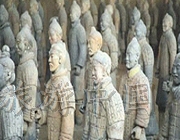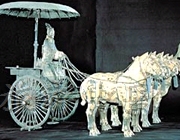The Mausoleum of the First Emperor of the Qin Dynasty (221 BC-206 BC), who successfully defeated all rival ducal states and unified China by establishing the first centralized feudal dynasty, is located at the northern foot of Lishan Hill in Lintong, Shaanxi Province. It is the largest mausoleum ever discovered in the world.
The mausoleum covers a total of 2.18 million square meters, with the tomb itself covering 220,000 square meters. The tomb was designed to be 166 meters high, but years of weathering and damage have reduced this to 76 meters. The bottom of the tomb measures 485 meters by 515 meters.
The mausoleum had lain undiscovered for almost 2,200 years, and they were discovered in March 1974, causing a sensation in international archeological circles.
Nearly 8,000 life-sized terracotta warriors and horses along with tens of thousands of pieces of weaponry were buried in three pits next to Emperor Qinshihuangs mausoleum, to guard the first feudal emperor of the Qin Dynasty.
The Warriors are now housed in a huge airplane hangar and despite their fame and the throngs of tourists visiting the site, they are still incredibly impressive. These life size warriors stand on guard as if preparing for battle. Historians believe that these magnificent men were originally painted. The paint has now worn and the original Bronze Age weapons (including swords, arrows and lances) that many of the soldiers carried only a few years ago are now locked up away from public eyes. Although there are 6,000 of the statues remaining, there were actually many more when the tomb was first built.
still incredibly impressive. These life size warriors stand on guard as if preparing for battle. Historians believe that these magnificent men were originally painted. The paint has now worn and the original Bronze Age weapons (including swords, arrows and lances) that many of the soldiers carried only a few years ago are now locked up away from public eyes. Although there are 6,000 of the statues remaining, there were actually many more when the tomb was first built.
It is the scale of this collection that is perhaps the most impressive aspect of the site. The Emperor must have been an incredibly influential and impressive man to deserve this great protection even after his death. The faces of the warriors are said to be modeled on the artists who sculpted them and on the actual Imperial guards at that time.
Qinshihuang moved into his underground palace at the age of 49 after ruling for 15 years and spending about 38 years building his mausoleum.
Further discoveries were made in 1976 when another 1,000 warriors and various other sculptures were dug up. Archaeologists also believe that there is possibly a larger and more impressive army still buried beneath the Emperors tomb.
The terracotta warriors and horses not only serve as a symbol of cultural exchange between Shaanxi and the outside of the world, but also as an "image ambassador" of China. It is regarded as "the eighth wonder of the world" for its large scale and great artistic quality, and has been listed as a world heritage site by the UNESCO in December 1987.
 So far, more than 50,000 valuable funerary objects have been unearthed. A museum was opened in October 1979 to give a full display as well as protection of terracotta warriors and horses. And now the government is working to construct a national park for the mausoleum. And more exhibition halls are also in the works.
So far, more than 50,000 valuable funerary objects have been unearthed. A museum was opened in October 1979 to give a full display as well as protection of terracotta warriors and horses. And now the government is working to construct a national park for the mausoleum. And more exhibition halls are also in the works.
The mausoleum have received more than 70 million visitors from both at home and overseas since they were discovered 30 years ago, according to an ongoing academic meeting.